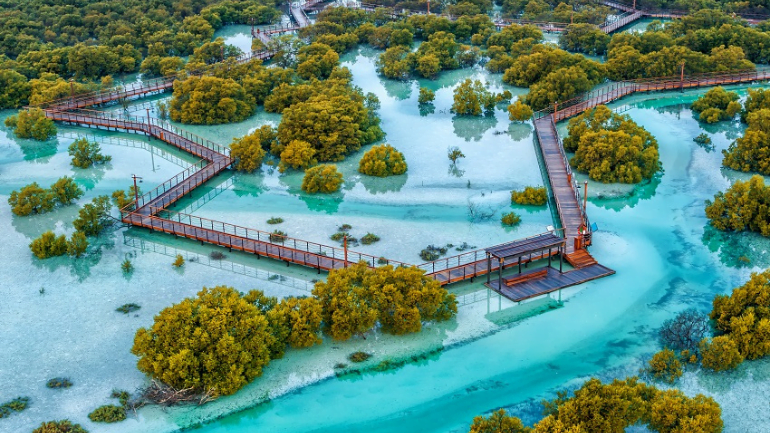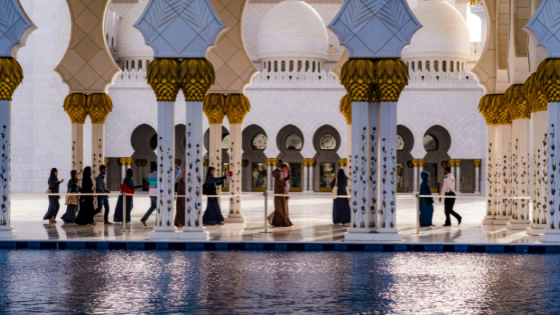Contents
- 1 UAE Mangrove Forests
- 2 UAE Mangrove habitat
- 3 The Eastern Mangrove Lagoon
- 4 Important of the UAE Mangrove forests
- 5 Mangrove forests in UAE heritage
- 6 UAE Mangrove Conservation
- 7 Top 5 UAE Mangroves to visit
- 8 Eastern Mangrove National Park, Abu Dhabi
- 9 Jubail Mangrove Park
- 10 Marawah Marine Biosphere Reserve
- 11 Khor Kalba Mangrove Center
- 12 Al Zorah Natural Reserve
UAE mangrove forests are steadily increasing in size and area, and the community and leaders of this country will need to protect them from new developments and urban expansion. Mangrove forests are critical to preserving the UAE coastline, but they are also under constant threat. Among these threats are coastal development, pollution, sedimentation, tidal flow changes, and human-caused activities.
As divers and marine enthusiasts, we have a responsibility to preserve and protect the mangroves by raising awareness and ensuring that our activities have the least possible impact on the surrounding environment.
Read more: Dubai budget travel tips
UAE Mangrove Forests
The tropical Mangrove forests, which are unique marine ecosystems, also known as the Guardians of the Coast, cover thousands of hectares along the UAE coast and are an important and integral part of the country’s coastal ecosystem. The most common species in the UAE is Avicennia marina, also known as gray mangrove. There are approximately 3000 hectares of mangrove forest in the UAE, with 2300 hectares located in Abu Dhabi.
UAE Mangrove habitat
Mangroves provide a great habitat/home and safe breeding ground for some fish species, turtles, and even commercially important shrimp, snapper, grunt fish, and sea bream, as well as a haven for birds nesting, migrating, and egg laying. Mangrove forests are found in intertidal zones and play an important role in preventing coastal erosion caused by wave action and ocean currents.
They are also a good source of food and fuel, as wood has historically been used to build houses and ships due to its hardness and resistance to rot and termites.
Take a look at: Best Dubai Brunch Places
The Eastern Mangrove Lagoon

Eastern Mangrove Lagoon is the closest mangrove forest to Abu Dhabi City and a popular destination for sea paddlers. It is known as the Eastern Mangrove Lagoon National Park. It will be the first of five national parks designated in the Abu Dhabi 2030 plan. Other areas include Abu Abyadh, Al Aryam, and Abu Dhabi’s Al Dhabeia islands.
Read more: Style at Dubai Beach Party Events
Important of the UAE Mangrove forests
UAE mangrove forests are known as “Qurm” in the UAE and cover 155 square kilometers of the UAE’s coastlines. Because of their durability and high resistance to rotting and termites, local populations used mangrove trees as a source of food, fuel, and building materials for homes and ships in the past. In addition, there are 13 important mangrove sites in the UAE:
- Saadiyat Island, Abu Dhabi.
- Jubail Island, Abu Dhabi.
- Marawah Marine Biosphere Reserve includes the Bu Tinah Island, Abu Dhabi.
- Bu Syayeef Protected Area, Abu Dhabi.
- Ras Gharab, Abu Dhabi.
- Mangrove National Park, Abu Dhabi.
- Ras Ghanada, Abu Dhabi.
- Sir Bani Yas Island, Abu Dhabi.
- Ras Al Khor, Dubai.
- Mangrove and Al Hafiya Protected Area in Khor Kalba, Sharjah.
- Sir Bu Nair, Sharjah.
- Al Zora Wetland, Ajman.
- Khor Al Beidah Wetlands, Umm Al Quwain.
Mangrove forests in UAE heritage
The late Sheikh Zayed bin Sultan Al Nahyan, the UAE’s founding father, recognized the importance and high value of mangrove trees and launched a massive forestation program that contributed to an increase in the number of mangrove trees in the UAE.
With more than 35% of the world’s mangroves already destroyed, these forests are in jeopardy. This is due to coastal development, which is causing habitat loss. They cannot be replanted once they have died. Mangrove regeneration in former habitats is difficult, if not impossible.
Read more: UAE Natural Landmarks
UAE Mangrove Conservation
Mangroves protect coastal areas from erosion by creating a buffer zone, filtering and calming tidal flows, and can even reduce tsunami damage and loss of life. Mangroves are critical for the UAE, and with rising sea levels, I expect them to play an important role in protecting our shorelines from erosion. Mangroves serve as nursery habitats for a number of commercially important fish and shrimp species.
Historically, mangroves also provided fodder for livestock and were an important building material prior to the discovery of oil. Mangroves also provide recreational opportunities, as demonstrated by the Mangrove National Park in central Abu Dhabi. So, we can raise awareness and take action to protect mangroves on these days:
- World Wetlands Day, 2 February.
- UAE Environment Day, 4 February.
- World Wildlife Day, 3 March.
- Earth Day, 22 April.
- International Day for Biological Diversity, 22 May.
- World Environment Day, 5 June.
- Coastal Clean-up Day, 15 September.
- World Habitat Day, 1st Monday in October.
Take a look at: UAE Geological Heritage Sites
Top 5 UAE Mangroves to visit
There are numerous centers in the UAE that you can visit with your family. Here are five mangroves and wetlands to visit in the UAE. However, remember to keep the area clean and not litter. While most of these locations are free to visit, some activities, such as guided tours and kayaking, are not.
Eastern Mangrove National Park, Abu Dhabi

The Mangrove National Park is a reserve of beauty and biodiversity located away from the city’s skyscrapers and bustling roads. The park is located on the city’s northern outskirts, near Reem Island. This stunning park, which is protected by the Environment Agency Abu Dhabi (EAD), accounts for nearly 75% of the UAE’s total mangrove forest area. This biodiversity hotspot is home to salt marshes, mudflats, algal communities, water channels, dense forests, wildlife, and other natural features.
Read more: UAE Coastal Geography
Jubail Mangrove Park

Jubail Mangrove Park in Abu Dhabi is a self-contained educational mangrove sanctuary. Many avian and marine species native to Abu Dhabi can be seen and explored here. Walking through the mangroves on the boardwalk. The boardwalk has an admission fee. There are also walking tours with a ranger that are priced for children.
Marawah Marine Biosphere Reserve

The incredible Marawah Marine boasts 120 km of immaculate coastline and over ten islands and was named the first marine biosphere reserve in the UAE, covering 63 percent of Abu Dhabi’s marine protected areas. The reserve’s 4,255 square kilometers are home to vital marine ecosystems such as seagrass beds, coral reefs, macroalgae outcrops, and mangrove forests.
Marawah is also home to the world’s second-largest bird community, 70 percent of the UAE’s migratory birds, and over 150 species of fish. It is home to a diverse array of marine and coastal ecosystems, such as seagrass beds, coral reefs, and mangroves. Marawah has historical, cultural, and archaeological significance in the UAE.
Take a look at: UAE Karst Topography
Khor Kalba Mangrove Center

The Kalba Conservation Reserve has breathtaking landscapes, diverse ecosystems, and activities for every nature lover. It is located on Sharjah’s east coast, about a 90-minute drive from the city center. It has clear waters for kayaking near the mangrove forest. There are also many spots near the water where families can pitch a tent and enjoy the weather in Kalba under a star-studded sky.
Read more: Humidity Levels in UAE
Al Zorah Natural Reserve

Al Zorah Nature Reserve’s thriving biodiversity provides a safe haven for approximately 58 species of native and migrating birds. This ecotourism destination in Ajman, UAE, is a great place to see egrets, herons, and pink flamingos, among other avian populations.
The natural reserve is located on the northern side of Ajman in the Al Zorah area. The area is directly accessible from Ajman’s Al Ittihad Street. Travelers coming from Sharjah or Dubai can take the Sheikh Mohammed Bin Zayed Road to the Al Zorah Nature Reserve.
The mangrove tour is one of the most popular tourist attractions in Al Zorah Natural Reserve. You can take one of the guided mangrove kayaking tours through the natural mangrove forests.
Read more: Detailed Geography Political UAE Map
Why are mangrove forests important in the UAE?
The UAE’s mangrove forests are vital for nesting birds. They help to prevent shoreline erosion and provide a plentiful food source for many animal and insect species. The UAE government has protected the Mangrove National Park, which is a dense forest.
Where are mangrove trees found in the UAE?
Mangrove trees are in the Mangrove National Park stretches along the eastern coast of Abu Dhabi. The Eastern Mangrove Lagoon National Park, located further south, is a protected 8-kilometer coastal stretch of forest that skirts Abu Dhabi’s airport.
How many mangrove trees are there in the UAE?
The UAE already has 60 million mangroves, which form forests spanning 183 square kilometers and capture 43,000 tons of CO2 each year.
Does the UAE have a mangrove forest?
The UAE’s natural wonders do not stop with glittering shorelines and rugged deserts. Abu Dhabi, the Emirati capital, is surrounded by 110 square kilometers of mangrove forests and dense wetlands, which are home to a variety of wildlife, including fish, turtles, and more than 50 bird species, including flamingos.
UAE Mangrove forests grow on waterlogged, salty soils on sheltered tropical and subtropical shores. The trees and shrubs are flooded twice a day by rising tides and can withstand harsh conditions such as highly saline soil and brackish water. These forests serve as natural coastal guardians, absorbing large amounts of carbon dioxide and other greenhouse gases such as blue carbon.













